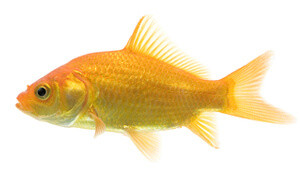The iconic bubble shape of the standard goldfish bowl has been for years the go-to home for a new pet goldfish. It’s the image almost everyone associates with a first-time fish owner. There are a few reasons for this connection. The first relates to a common misconception that people make by associating the small physical size of a goldfish bowl with it being easy to maintain. The other reason relates to the goldfish and the fact that most are rather inexpensive. This unfortunately makes it easy for people to not put a high value on the life of one. In the event it dies by improper care of an inexperienced owner, they can simply go purchase another one for less than a dollar.
Many pet goldfish do not live as long as they should. Goldfish have the potential to live for a decade or more not a year or even just months. The cause of this shorter lifespan is due to improper care. Two common mistakes include overfeeding and infrequent water changes.


Minimum Bowl Size: Warning
A basic rule on the amount of living space your goldfish needs to stay healthy is 20 gallons (75 liters) or so per every one adult fish. Realistically though, not everyone is going to have a 20 gallon goldfish bowl with just one fish in it? They can survive in a smaller size tank, but, it can stunt their growth and will shorten their life-span if you never upgrade to a larger living space as the fish grow. You need to upgrade when the get bigger! Additionally, a small bowl will require a lot more maintenance to keep the bowl clean and the goldfish healthy. Read about the nitrogen cycle or the next beginner post on Goldfish Bowl Water for more info on water quality.
Oxygen Levels Matter
The more goldfish you have in a tank, the more oxygen that is required to keep them healthy. Try adding an air pump to agitate the surface of the water. The air bubbles don’t actually add oxygen but the agitation of the surface will help.
The best solution on maximizing oxygen in the water is to follow the rule of the greater the amount of surface area, the more oxygen in the water. For this fact, choose a wide goldfish bowl over a tall narrow one.
If you have the classic bubble-shaped goldfish bowl, don’t fill it to the top since filling it to the top doesn’t provide the most surface area. Understand that more surface area is better than more water when it comes to your goldfish’s health. If you fail to provide enough oxygen your pet can suffocate and die.

Recommended Upgrades
Iconic Bowl Shape 2.75 Gal10 Gal Aquarium Kit
20 gallon Kit
How to Clean a Goldfish Bowl
If you choose to keep your fish in a small goldfish bowl instead of a larger aquarium or pond, you will have to change the water almost daily. This is because goldfish in general produce a lot of ammonia waste. You can limit this by not overstocking, overfeeding, or leaving waste to rot. If you are thinking about adding an algae eater, you will need to provide it space to live and grow too. You will also need to keep the water around 77F/25C, which is too warm for goldfish ideally prefer. For these reasons, don’t add an algae eater. It’s not necessary anyway.
- To clean the water take out 50-75% of the goldfish bowl’s water and replace it with clean water that contains no chlorine. You can add a few drops from a de-chlorinator to remove any chlorine from the water.
- If you are careful and act quickly to do the water change, you can probably leave the goldfish in the goldfish bowl you are cleaning. During this time you can scrub off any algae with a clean rag with no chemicals or detergents in it. We recommend an algae scrubber that you can get from your local pet store.
- Lastly and importantly, add a drop or so of water de-chlorinator (Read the instructions on the bottle for exact measurements).
Note that a little bit of algae in a tank is a good thing. It adds oxygen into the water and provides a good source of snack food for your goldfish.
Things that might help in your cleaning process
Master Water Test KitWater Dechlorinator
Goldfish Food

There are dozens of types of goldfish food on the market today and they come in a variety of forms and ingredients. Goldfish are omnivores which means they eat both plants and animals. However, they are mainly herbivores and shouldn’t only be fed animal products. Many hobbyists only buy and use one brand of goldfish meal and their pets live long lives. However, by mixing in several types of diet options, it ensures that the fish get a well-balanced diet.
Diet Options
Forms of goldfish food come in:
- Flakes
- Pellets
- Wafers
- Sticks
- Animals/Plants
Processed and prepared as:
- Dry food
- Freeze-dried
- Frozen
- Living
Ingredient that are found in these forms and prepared types of food:
- Tubifex worms
- Brine shrimp
- Blood worms
- Krill
- Plankton
- Mysis
- Shrimp
- Cyclops
- Daphnia
- Mosquito larva
- Algae and plants
TetraFin Plus Goldfish Flakes With Algae To Promote Health
How Much per Feeding
Goldfish are cold-blooded which means they don’t need as much food as warm blood creatures. Since gold blooded animals don’t need to use energy to heat themselves up, they can go much longer without being fed. A fish could go a week or longer without eating. They will be hungry but not starving. A fish won’t shrivel up and die, but, they will stop growing during that time. When it finally starts eating again, it will begin to grow. Underfeeding is rarely the cause for concern, it’s overfeeding that causes the most problems. Often those problems include constipation and swim bladder problems.Here is the rule of thumb for feeding; only feed them as much food as they can eat in 2-3 minutes. Overfeeding can be fatal because goldfish are opportunistic scavengers and will continue to eat as long as there is food in the tank. This can lead to a burst intestine. That means they die. Overfeeding will not make them grow faster; it is more likely to kill them. If you want them to grow, give them plenty of space to grow and maintain the health of the tank.
How Often to Feed
There is no clear answer to this question. In the wild, these fish eat tiny meals throughout the day and are healthy. Smaller meals more frequently are easier on the digestive tract. Small meals include a few flakes or pellets per fish. Observing behaviors during feeding time will help owners know if their pets need more food. If the goldfish appear to still be in a frenzy when all the food is gone, they might need a bit more next during the next feeding. It’s important to observe all of them individually to see if they are getting their fair share. That’s good goldfish care advice to follow.


Sick Goldfish
Don’t attempt to pick up or handle your goldfish because it will rub off the protective slime coat layer which helps the fish stay healthy.
Constipation: Symptoms include the fish floating on its side on top of the water, or it has a swollen belly. The Cure is to add greens to its diet, Peas are a great food to include in their diet. It helps like a laxative. Live plants will also help with this problem. Swim Bladder: Symptoms include an inability to stay upright. the goldfish might face downwards, on its side or even upside down. It is not to be confused with constipation but treating the goldfish with the same methods as stated above can help minimize the effects of the swim bladder. There is no cure to swim bladder as it is a genetic problem. read more about swim bladder disease Ich or Ick: Ichtyopthirius Symptoms include white spots on the body or fins and sometimes rapid gill movement. Cure it by cleaning your tank entirely (to remove the parasite that may be growing) and contacting your pet store for Ich medication. However, those can be rough on goldfish so try using aquarium saltat a level of (3 teaspoons per gallon). Not all fish can handle this so make sure you only treat your infected goldfish.Ammonia Poisoning: Symptoms of this include black and burned looking skin, especially on the tips of the fins. The first thing to do is to immediately perform a water change. You might then add a medication that helps promote the healing of the protective slime coat. Next, buy an ammonia test kit to help you know when you need to change the water. Often in a bowl, you will need to change the water a few times a week or more.
Goldfish Facts
- 43 years is the record for the longest life span of a goldfish.
- The maximum length of a goldfish is 23 inches.
- Goldfish can’t close their eyes.
- They do in fact sleep, just not like we do.
- Goldfish do not have a memory of 3 seconds; it’s more like three months.
- You can train a goldfish to memorize colors and shapes.

Fact: According to Wikipedia, there are over a 300 goldfish species. See some of them in our identification video or read about it on our goldfish breeds article, Right Here.
Related Content
FAQ
Q: How much can a goldfish weigh?A: Fully grown goldfish can weigh up 10lbs (4.5kg) but that is rare. However, it’s not unrealistic for a goldfish to be 5lbs (2.25kg).Q: Do goldfish have ears?A: Goldfish do have ears but not like you and I. They have internal ear bones called an otolith that can feel vibrations. Avoid tapping on the glass since it will stress or even kill them.Q: Do goldfish have lungs?A: Goldfish do not have lungs. Goldfish breathe by drawing in oxygenated water through its mouth. It then closes its throat and forces the water through gill openings where the oxygen in the water is absorbed (inhales) into the fish. The water is pushed out through the gill openings, taking with it the (exhaled) carbon dioxide and ammonia. The gills in fish are the equivalent of lungs in humans. Oxygen gets inhaled through tiny membranes in the lungs or gills and CO2 (and ammonia in fish) is exhaled.Q: What is the coldest water temperature a goldfish can survive in?A: The common goldfish can survive in an outdoor pond where water temperatures dip down below 40*F (5*C). They will go into a semi-hibernation by sitting, not really moving much and not eating down at the bottom where the water is warmest. Some pond might even freeze over during the winter and the goldfish still survive through to the spring.Q: Can you water your plants with dirty aquarium water?A: You can water your house plants or garden plants with your dirty tank water. The nitrates and fish waste in the water are a great fertilizer for your plants.
Goldfish Ponds
Aquarium TanksGoldfish Information
Types of Goldfish Breeds
Add New Fish
Article Citations and Resources
- Johnson, Erik DR.,and Richard Hess. Fancy Goldfish: Complete Guide To Care And Collecting. Weatherhill, Boston, MA. 2001.
- Boruchowitz,David. Aquarium Care of Goldfish. T.F.H Publication, Neptune City, NJ. 2008.
- Brewster, Bernice. An Essential Guide to Keeping Goldfish. Interpet Publishing, Surrey, ENG. 2003.
- Halls, Steve. Your Healthy Garden Pond. Howell Book House, Foster City, CA. 2000.
- Sweeney, Mary. The 101 Best Aquarium Plants. T.F.H, Neptune City, NJ. 2008.
- Nico, L.G., P.J. Schofield, J. Larson, T.H. Makled, and A. Fusaro, 2018, Carassius auratus (Linnaeus, 1758): U.S. Geological Survey, Nonindigenous Aquatic Species Database, Gainesville, FL, https://nas.er.usgs.gov/queries/FactSheet.aspx?speciesID=508, Revision Date: 6/4/2018, Peer Review Date: 4/1/2016, Access Date: 8/7/2018
- Street, R. 2002. “Carassius auratus” (On-line), Animal Diversity Web. Accessed August 07, 2018 at http://animaldiversity.org/accounts/Carassius_auratus/
- ROZIN, PAUL, AND JEAN MAYER. Regulation of food intake the goldfish. Am. J. Ph ysiol. 20 (5) 1 968-974
- Ryback RS. A method to study short-term memory (STM) in the goldfish. Pharmacol Biochem Behav. 1976 Apr;4(4):489-91.
- Arthur Masloski. Goldfish: Myths Debunked. Tropical Fish Hobbyist Magazine. Issue: January 2009http://www.tfhmagazine.com/details/articles/goldfish-myths-debunked.htm
- Carrie Arnold 3-Pound Goldfish Found—How’d It Get So Big?. National Geographic Blog. January 18, 2013.
- Craig A. Watson, Jeffrey E. Hill and Deborah B. Pouder. Species Profile: Koi and Goldfish. SRAC Publication No. 7201. September 2004.
- Shivappa RB, Christian LS, Law JM, Lewbart GA. (2017) Laboratory evaluation of different formulations of Stress Coat® for slime production in goldfish (Carassius auratus) and koi (Cyprinus carpio) PeerJ 5:e3759 https://doi.org/10.7717/peerj.3759
Reviewed By: Tim Winter


Tim Winter has a strong affection for pets and wildlife. His years of experience caring for various types of pets has led him to share his knowledge with others on the best practices in pet care. Tim holds a Bachelor of Science from the University of Oregon School of Journalism and Communications.
